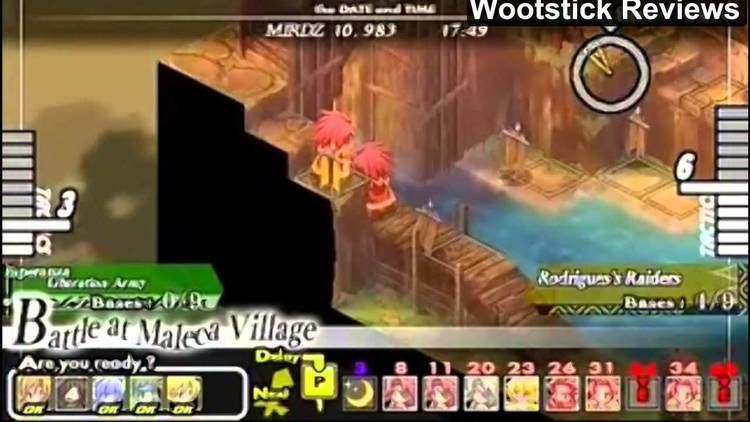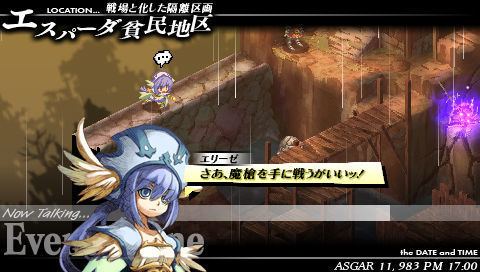6.8 /10 1 Votes6.8
Mode(s) Single player | 68% Metacritic Initial release date 19 May 2011 | |||||||||||||||||||||||||||||||||
 | ||||||||||||||||||||||||||||||||||
Designer(s) Shinichi Ito (Producer)Hiroki Asai (Scenario)Satoko Kiyuduki (Character Design)Yoshinori Iwanaga (Monster Illustration)Yukio Takatsu (Opening Animation Director)Shigeki Hayashi (Composer)JaJa (System, Concept, and Screen Design) Similar Dept Heaven games, Atlus games, Tactical role-playing games | ||||||||||||||||||||||||||||||||||
Gungnir, full title "Gungnir: Inferno of the Demon Lance and the War of Heroes" (グングニル -魔槍の軍神と英雄戦争-, Gunguniru: Masou no Gunjin to Eiyuu Sensou), is a tactical role-playing game for the PlayStation Portable, developed by Sting Entertainment and published by Atlus. It is Episode IX of the Dept. Heaven series, and was released in Japan on May 19, 2011 after two years of development.
Contents

Gameplay

The gameplay flow of Gungnir is divided between event scenes, battles, and breaks between each stage in which the player may buy new equipment and change the equipment of party characters. The game display is isometric, with hand-drawn character sprites and environments rendered in 3D, and the official website describes the game as using the orthodox tactical RPG system as a base while employing a time system and an all-new mechanic known as the "Tactics Gauge".

According to the game's product page on Gamestar, Gungnir will feature an optional support mode for players struggling with the system and difficulty level. Both multiple routes and Easy Mode were later confirmed by an interview appearing in Gamers Magazine.

Up to ten generic units may be recruited at any one time; Julio and any storyline characters accompanying the party do not count for this total.

There are twelve generic unit types: Garrison, Assassin, Trickster, Gunner, Shooter, Sorceress, Paladin, Breaker, Venery, Archer, Priestess, and Witch. In addition, eight monster classes exist: Harpuia, Skeleton, Drake, Undine, Pixie, Vampire, Golem, and Rail Cannon. Most major story characters have their own unique classes. New units can be permanently recruited in between battlefields.

The gauge displayed on the left side of the screen is known as the Tactics Gauge, and the Tactics Points used to fill the gauge can be employed for various functions. The more Tactics Points are in the gauge, the stronger the party's attacks will be, but these points may also be used for the Scramble function, which interrupts the natural turn order and allows the player to mobilize his or her army any time they please. Tactics Points are primarily gained by obtaining control over key locations of each battlefield.
Two extra methods of attack that rely on cooperation between allies. Beat involves up to four extra allies joining in to attack the targeted enemy as long as they are within the plus-shaped target locus; Boost involves allies on a similar locus extending from the initiator lending their strength for a single powerful attack. How many squares these loci extend depends on how many key locations the player controls.
Once the player has obtained Gungnir itself in the story, Julio can use it to summon great demons called the Inferno (軍神, Gunshin) or "gods of war" to produce various field-wide effects. Doing so costs Tactics Points. Three of these beings were introduced in an online Famitsu announcement. There are five in all, and they are all named after figures in Norse mythology. The first to join the player is Einherjar, the god of rebellious spirit, which deals damage. The second is Midgardsormr, a monstrous beast that destroys equipment. The third is Vánargandr, which both inflicts status effects and deals damage. The fourth is Lífþrasir, who bears a resemblance to series mainstay character Marietta, and heals status effects, damage, and vitality. The last is Fimbultyr, which bestows the Brave status effect. Whether or not the Inferno other than Einherjar awaken and become usable depends on how much Quality Gungnir has.
The game features nine decision points during cutscenes, which determine both the general path of the game and the contents of each ending. Certain scenes vary based on the player's choices and thus Giulio's behavior.
Story
Gungnir begins in the year 983 and takes place in the empire of Gargandia, a country populated by two races: the upper-class Daltania and the peasant Leonica. The Leonica race is regarded as "cursed" for yet unknown reasons, and is subjected to harsh class discrimination.
Because of this and incidents such as the "Espada Massacre" that occurred over fifteen years ago, a group of Leonicans aided by Daltania sympathizers has formed a resistance army called Esperanza. Their resistance is, however, badly outmatched and struggling.
One day, a young platoon leader in Esperanza named Giulio comes upon a slave trader taking a kidnapped Daltania girl out of the country, and he and his men rescue her. He welcomes the girl, Alissa, into Esperanza, although she worries what response this will bring from the Daltania military.
Shortly after this, during a desperate battle that appears as though it may cost Giulio's life, a powerful demonic weapon appears before him. Identifying it as the demon lance Gungnir, he decides to take it up, and uses it to seize victory from the jaws of defeat, striking terror into the hearts of many. Giulio and Esperanza come to believe that Gungnir will give them the power they need to win the war with the ruling class, but this acquisition causes Giulio's destiny to begin moving.
Characters
Development
Details about Gungnir and its development first emerged in JaJa's blog as early as May 2009, where it was referred to by the code name "9th". However, while 34 entries were posted over the course of May and June of that year featuring development talk and occasional postings of concept artwork, JaJa's blog went silent after that time. While Sting initially projected that the game would be released in late 2010, no more was said about it during the development of Yggdra Unison's DS remake, Hexyz Force, the PSP version of Knights in the Nightmare, and Blaze Union, which were developed and released from late 2009 to mid-2010.
The project resurfaced in February 2011 with an announcement in Famitsu magazine, followed by the appearance of a teaser site maintained by Sting and hosted on Atlus' domain. On February 24, JaJa uploaded his first post in two years, confirming Gungnir as Dept. Heaven Episode IX. According to JaJa, part of the reason he had not updated his blog during this time was because Sting received a great deal of help on Gungnir from people outside the company itself, and he was worried about causing trouble if he mentioned things that weren't supposed to be revealed yet. Attached to the post in question is a sketch by Satoko Kiyuduki featuring the four main characters of the game backstage at the Famitsu announcement, complaining about their two-year wait.
JaJa remarked in his production blog that "This time we're not going for the 'What the heck is this?!' mysterious approach of Knights in the Nightmare... I think it'll be the type of thing where people will look at the game screen and wonder, 'Is it this type of game then?' And at first, that guess will be right on. However, as you play the game, parts that make you go 'Huh? What's this??' will pop up all over the place if we can get the finishing touches right".
According to a post by Kiyuduki in the staff blog, the game's visuals originally had a much more super-deformed feel to them before changes were made based on Asai's script and Ito's orders for retakes. The opening movie, which was completed fairly early into production, retains the softer and more baby-faced versions of the characters from that time.
Atlus USA announced the English version of the game will be released on June 12, 2012.
Merchandise
A demo build of the game was made available for download from the Japanese PSN starting on 14 April 2011. It includes the first three stages of the game and the first scene of the fourth, as well as all branches created by choices up to that point.
In addition, a prerelease mini-album is available for download through iTunes, distributed by Atlus. This release contains the three tracks that play randomly on the Gungnir homepage: The title track Gungnir (ガングニール, Gunguniru), battle theme The Noble Ones (高潔なる者たち, Kouketsunaru Monotachi), and Theme of Alchemy (錬金術のテーマ, Renkinjutsu no Teema) (Paulo's theme).
Preorders of the game from certain online stores (Messe Sanon, Medialand, Imagine, Softmap, and WonderGOO) come with a phone card featuring special illustrations of certain characters (Fiona, Natalia, Alyssa, and Elise respectively).
The game's strategy guide, "Gungnir -Inferno of the Demon Lance and the War of Heroes- Official Complete Guide", will be produced by Softbank Creative and sold starting on June 3. The 2-disc official soundtrack was released under the SMD itaku label on June 22. An official art, documents, and settings book will be released on August 3, also by Softbank Creative.
Reception
Gungnir has received mixed reviews. Tech-Gaming found the game's battle system to offer a nice variation on strategy role-playing formula and lauded the game's charming graphical style which consistently offers a plethora of information but bemoaned the game's plodding introduction.
